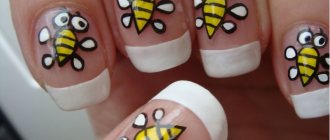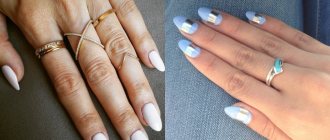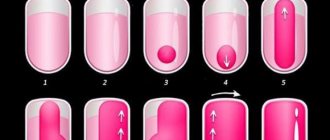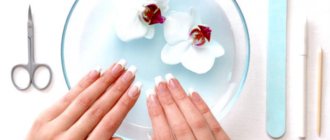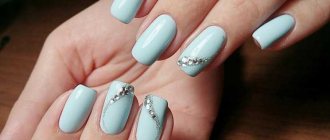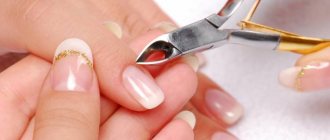Throughout the year, the fashion for manicure nail shapes constantly changes; girls prefer to make non-standard designs that cannot be found in others. However, before you shape your nails, you should pay attention to the peculiarities of manipulation.
You can always perform the procedure yourself if you know how to give your nails a beautiful design without spoiling their original state, since there are some subtleties in the technology, failure to comply with which can impair the quality of the nail bed.
Correct filing of nails, basic mistakes
While some women prefer to get their nails done in salons, most still try to take care of their nails at home. Some people do it extremely professionally, while others suffer, making a huge number of mistakes.
The most common mistakes women make when filing their nails:
- Most women use low-quality nail files and therefore are not always pleased with the result of the work done with their own hands. The choice in modern stores is quite large and most often ladies buy a nail file without thinking at all about what it can do to their nails. You should know that the rougher the file, no matter how advertised it may be, the greater the likelihood that it will leave microcracks on the surface of the plate. Microcracks subsequently become the beginning of nail breakage. In everyday life, when moisture gets on the nail or it hits the surface, it is quite possible to get a break. Preference should be given to glass and ceramic nail files. Of course, they are more expensive, but in the end, they will be able to please you with a positive result. Also try to always use a nail polishing file, which effectively smoothes all the edges of the nail, rubbing out cracks.
- Another mistake is filing nails with a layer of varnish. Such an activity can quite realistically provoke delamination of the nail plate. If the need for filing is very great, then this should be done with several gentle movements, just removing the sharp tip. This filing will help the nail not to cling to clothes, hair and tights, solving many of your problems and getting rid of unpleasant situations
- A serious mistake is to file your nails simply out of boredom. Too frequent impacts on the nail, vibration of the file and micro cracks will lead the nail to a deplorable state. Remember that high-quality nail filing should only be done once a week.
- Significant harm can be caused to the nail if you are constantly distracted from filing it. Of course, this way you will make the process more interesting, but while watching TV, talking with loved ones and simply taking your eyes off your hands, you risk injuring your nail, which will lead to its delamination and breakage
- The filing technology is of great importance because the usual movements “back and forth” are unnatural to the very structure of the nail plate. If you want not to harm the nail, movements should be made from the edge to the center
- You should not file wet nails, as in this state they are more susceptible to injury caused by a file than dry ones. A particularly serious mistake is considered to be the initial soaking of hands in the bath and subsequent filing
- Other mistakes include such violations as: using a file as a tool not only for nails (it can only file the nail plate, other surfaces spoil it), deep filing of the sides of the nail plate (such filing leaves cracks on the nail that has not yet grown and dooms it to break), improper holding of the nail file
How should you file your nails correctly?
About the features of care
Nail plates are horny growths (similar to animal claws) that form on the dorsum of the outer phalanges of the fingers. Being derived from the epidermis, they need proper care, regular procedures such as filing, steaming, polishing. Many people underestimate the importance of doing these steps.
Why is it important to file your nails correctly? The plates are made of keratin, a hard substance produced by the body. Located primarily on the nail bed, it protects fingers from mechanical damage and helps avoid minor injuries. It also turns out to be the most susceptible to the negative influence of the environment, which is why it quickly becomes thinner and brittle. The listed circumstances make filing not just one of the stages of manicure, but an important procedure that allows you to improve the general condition of the plates.
When starting a manicure, think not only about how to file your nails beautifully, but also about how to keep them healthy!
There are three main groups of manicure tools:
- basic;
- special;
- cosmetic.
The first group is represented by means for removing varnish, buffs and polishing files, as well as baths, steaming compresses, and liquids for removing or softening the cuticle. Special tools include a variety of gels and tonics that provide nutrition and restoration of the nail plates and accelerate tissue regeneration. The cosmetic group includes varnishes and glitters.
“When making an appointment with a nail specialist, the vast majority are worried about the sterility of the tweezers and files used. Unfortunately, such suspiciousness does not persist when doing a manicure yourself. Household instruments may be stored in inappropriate conditions and not sterilized, which few people care about. This is a fatal mistake, which sometimes leads to very sad consequences,” says leading podologist Oksana Shikhman.
How to properly file nails on oval-shaped hands?
There is probably no woman who has never filed her nails to give them a more aesthetic appearance, neatness and practicality. But in addition to the fact that you need to be able to file, it is also important to know the features of files, techniques and methods.
There are certain generally accepted nail shapes that women try to maintain: square, oval, almond-shaped. Modern nails are natural nail plates and extensions with special material. In any case, they require attention and care.
basic nail shapes
An oval nail shape is very feminine. This is a classic option for shaping the nail plate. This shape can even effectively visually lengthen your fingers.
Giving your nail an oval shape is not difficult:
- Get a quality manicure: remove polish from the surface of the plate, clean the nail, remove cuticles and hangnails
- Take a file and first, with smooth movements in one direction, file the edges of the nail plate from the sides to the center
- It is important to know that the movement of the file should be stopped approximately two (maybe a little more) millimeters before the middle of the nail
- If there remains a fairly sharp tip in the center of the nail plate, round it off with horizontal movements as a final result.
- Using a polishing file, rub the edges to make them soft and sloping, and also to avoid microcracks.
Sawdust
The sawing is always performed with orientation towards the central axis - a vertical straight line drawn along the length of the plate from the cuticle to the free edge.
The purpose of the sawdust is to make the parts of the plate symmetrical from the central axis.
The form is filed only to the ingrowth points along the edges of the plate. Usually there is a slight expansion in the area of growth points. It is necessary to remove the protruding width, adjust the shape, creating parallel straight lines on the sides, and at the same time not make it too narrow or bend the overall shape.
What should be the abrasiveness of a sawdust file? Suitable options are 180 x 200, 200 x 200, 200 x 220 grit. Less than 180 is too rough, and more than 220 is already a grinder. The file should be wide and slightly arched for ease of use. If it is new, it is necessary to treat the edges with a buff so that they do not cut the skin.
How to file almond-shaped nails?
The almond shape is not just a pretty nail shape, it is the most feminine, fashionable and popular way to highlight your hands. This shape visually lengthens the fingers, making them refined, “cat-like,” playful and beautiful.
In some ways, the almond shape resembles a claw. This claw adds charm to a woman and makes her nature more passionate. At the moment, French manicure on almond-shaped nails and a solid red or black base color are very popular.
This form can safely be called classic, because it has existed for a very long time, but has never lost its relevance. It is worth noting that almond-shaped nails should not have any sharp corners, as is observed in the almond nut itself. However, the edges of such a nail and the tip are narrower when compared to the hole of the plate.
It would be quite difficult for a non-professional to model such a shape on nails. This requires precision so you get a nice shape without making the plate too sharp. The most difficult thing, according to women, is to make absolutely all nails the same.
almond shaped nails
Another feature of this form is the presence of sufficient length at the nail. It will not be possible to model nails that are too short. The ideal length of such a nail should be comparable to the bed itself.
Technology for giving almond-shaped nails:
- First of all, perform a thorough manicure, removing all dirt from the nail, varnish, cuticles and hangnails.
- Giving an almond shape involves the initial formation of a square nail. Using nail scissors, trim the tips of your nails into a straight line.
- Use a nail file to file down the sharp corners on both sides. This way the nail will take the shape of an extended trapezoid.
- A softer file should soften the edges of the plate and give the nails a more final shape by squeezing the corners. The nail will gradually take on an almond shape
Which nail file is better to choose?
Before choosing a file, you need to decide what exactly it is needed for. All nail files can be divided into four groups, depending on the main function:
- tools that give the desired shape to nails made of artificial materials (for example, acrylic);
- files intended for the care of natural nails;
- files used to seal the edge of the nail;
- grinding tools.
Files also differ in hardness. The toughest ones are used for working with artificial nail plates. Experts say that the most durable and easiest to use files are glass ones. They are inexpensive and are often used at home. However, they are fragile and often break.
Professionals most often use nail files with ceramic coating. With their help, you can not only give shape, but also seal the edge of the nail. Using this tool you can carefully remove the cuticle. The only disadvantage of ceramic nail files is their high price. When working with artificial materials (for example, acrylic), professionals most often use diamond-coated files.
How to file square nails correctly?
Along with the almond shape, the square shape remains one of the most popular. Such nails suit almost all fingers, thin and full. Both French manicure and any other design look great on these nails. It is much more difficult to give a square shape to natural nails than to nail extensions, but it is quite possible.
square nails
Technology for creating square nails:
- Get a quality manicure: remove polish from the surface of the plate, clean the nail, remove cuticles and hangnails
- The length of the nail should be shortened to the desired size, while trying to make the line as even as possible and along the longitudinal axis of the finger
- You should start filing your nail, holding the file parallel to your finger so that the side is as even as possible.
- This type of sawdust is repeated on the opposite side of the finger.
- Make a horizontal file on the nail, giving it a square shape.
- There are three types of square nails: sharp square, soft square, round square. Each shape depends on how smoothly you cut the sharp corners on the sides
Length selection
How to choose the right length when performing a manicure:
- It is necessary to compare all the nails from the cuticle line to the free edge, and select the average desired length option, which can be designed on all fingers.
- If the client wants to leave the maximum length, then comparing all the fingers, it is necessary to choose the shortest one and align all the others according to it so that the nails are the same on both hands. If one of the nails is broken or damaged, then we select the next one with the minimum length, focus on it, and for the broken one we perform restoration with gel or acrylic.
- The second case is when the client wants to completely remove the length. In this situation, you need to focus on the length of the nail bed, without the free edge. The longest nail bed on 8 nails, excluding the big ones, will become a guide for the rest of the fingers. You may have to leave some of the free edge on some of your nails so that they all look the same when you apply the color.
- We separately compare 8 fingers on both hands without thumbs. We compare the thumbs only with each other, only approximately adjusting them proportionally to the rest.
When comparing, fingers are placed next to the alignment along the cuticle line. And already from the cuticle we look and select the total length of the nails for everyone and for each pair on both hands. The same length is selected not in mm, but proportionally.
- The largest one should be left on the middle finger, since the plate on it is naturally the shortest.
- Behind it, align the index and ring fingers equally.
- The length on the little finger will be the shortest, as it naturally has the longest nail bed.
If the client walks constantly, and the last time a certain length was already set, then at each next visit it needs to be selected and aligned again. Nails grow at different rates on different fingers and different hands, so it’s worth taking this into account.
The length of the plates should be the same from the cuticle line, regardless of the length of the immediate free edge. Under the coating, the free edge and smile line will not be visible. It follows that you can't just leave 1.5 or 5mm on each nail and expect them to look the same.
Is it possible and how to file extended nails?
Women who get their nails done in salons have many questions about filing. Such nails are also not immune to the fact that at any moment they can break, crack or form a sharp tip that can cling to hair and clothes.
You can avoid these troubles if you carefully file your extended nails. This can be done, but very carefully. The fact is that being too rough with your nails and filing them with a low-quality tool can lead to delamination, when the material literally tears off the layer of the plate to which it is attached.
It is important to know that such nails should be filed only with a special file. To do this, you will need an abrasive nail file, which is sold in nail art and manicure departments. Such a file can have several sides of different hardness.
filing extended nails
Shape square
This is the simplest form for sawdust. There are two types:
- Soft square;
- Clear square.
It is characterized by two edge lines parallel to the central axis and a clear perpendicular line of the free edge relative to the axis line.
With a clear square, the corners are clear, but not sharp. When soft, slightly rounded, but without disturbing the perpendicularity of the edge to the central axis.
In what order should you cut the square?
- First, use a nail file to remove the length perpendicular to the central axis. The file works at an angle of 90 degrees in a straight line with movements left and right.
- Here it is important to grasp the client’s finger in such a way as to ensure good visibility of the direction of the sawdust and not “overwhelm” the perpendicular direction.
- The next stage is sawing of parallel, smooth edges in relation to the central axis. To do this, a wide file is inserted under the plate, brought to the point of growth, installed parallel to the axis and sawing is made.
- We repeat on the other side. Work carefully so as not to saw through the plates at the point of growth; work only up to this point, starting the file from below. Do not run the saw over the plate in the corners so as not to make cuts.
If the nails grow in a trapezoid from the growth points, expanding towards the free edge, then as they grow in length they either sharply slant down or “fly up” upward.
With this initial shape, it is recommended to make the sawdust square, but to create even side parallels, you will need to narrow the nails a little towards the free edge so that they do not look like “shovels”. Exactly as much as there is expansion from the cuticle zone to the growth points. It’s as if we are adjusting the width to the original one at the cuticle. From the side, such a square will also look narrowed from the side parallels.
How to properly file nails with gel polish and shellac?
You can file nails with varnish or shellac, but this should be done with a fairly soft file. You cannot use hard abrasive, large or metal files because they can simply tear off the coating layer and lead to peeling of the nail.
The damaged nail will be much thinner and will be prone to frequent breaks and microcracks. File such nails very slowly and carefully, because if you do it in a hurry and ineptly, you risk ruining the entire manicure.
nail file with different hardness and polishing
How to file your nails if you don’t have a file?
There are situations when a nail breaks suddenly, and there is simply no special file at hand. If you still have a lot of work ahead, you should find a suitable object that can smooth the edges of a broken nail instead of a file. For this you may find it useful:
- An ordinary coin, the side of which (edge) has a ribbed surface
- A brick wall is a gentle nail file, but it can cause your nails to turn red.
- Asphalt is a harder surface, but it is just as effective at eliminating sharp tips on the nail.
Take care of your nails on time, always monitor their shape and listen to the recommendations for filing at home. If you take care of the beauty of your nails, they will also delight you with their health and strength in any situation.
Triangle and stiletto
Most often it is performed on extended plates and is characterized by a sharp, elongated tip. Also called "cat's claws". You will need a medium to long sawdust length. It is performed as for the almond shape, but without rounding, but with a sharp angle, starting slightly above the growing point, towards the central axis. For sawdust, it is necessary to have a pronounced semicircular arch in the architecture of the plate, otherwise there will not be a beautiful transition in length, and the nails will not be strong.
A wide file is inserted under the nail from the growing point and first the lateral parallels are drawn. From them, a light half-arc is created with a file, and from the middle of the length to the tip, an acute angle is filed.
